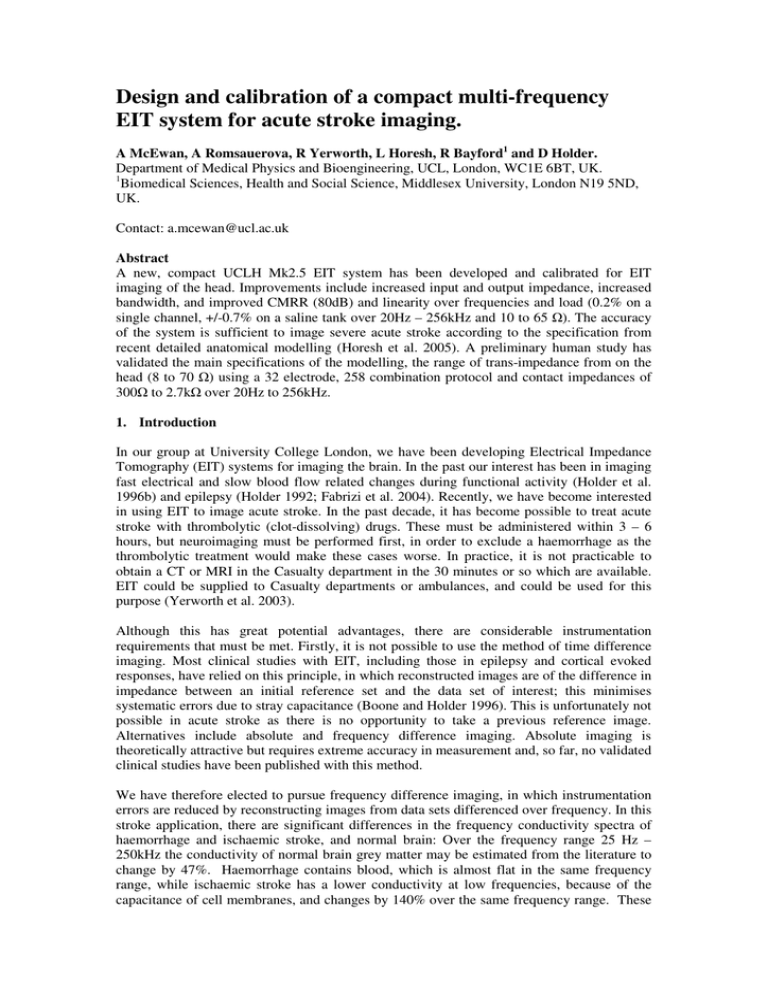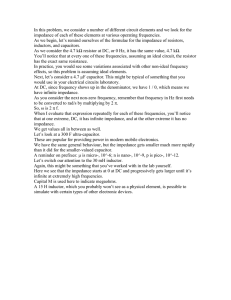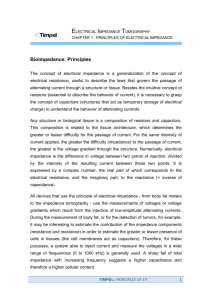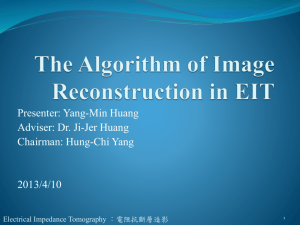Design and calibration of a compact multi-frequency
advertisement

Design and calibration of a compact multi-frequency EIT system for acute stroke imaging. A McEwan, A Romsauerova, R Yerworth, L Horesh, R Bayford1 and D Holder. Department of Medical Physics and Bioengineering, UCL, London, WC1E 6BT, UK. 1 Biomedical Sciences, Health and Social Science, Middlesex University, London N19 5ND, UK. Contact: a.mcewan@ucl.ac.uk Abstract A new, compact UCLH Mk2.5 EIT system has been developed and calibrated for EIT imaging of the head. Improvements include increased input and output impedance, increased bandwidth, and improved CMRR (80dB) and linearity over frequencies and load (0.2% on a single channel, +/-0.7% on a saline tank over 20Hz – 256kHz and 10 to 65 Ω). The accuracy of the system is sufficient to image severe acute stroke according to the specification from recent detailed anatomical modelling (Horesh et al. 2005). A preliminary human study has validated the main specifications of the modelling, the range of trans-impedance from on the head (8 to 70 Ω) using a 32 electrode, 258 combination protocol and contact impedances of 300Ω to 2.7kΩ over 20Hz to 256kHz. 1. Introduction In our group at University College London, we have been developing Electrical Impedance Tomography (EIT) systems for imaging the brain. In the past our interest has been in imaging fast electrical and slow blood flow related changes during functional activity (Holder et al. 1996b) and epilepsy (Holder 1992; Fabrizi et al. 2004). Recently, we have become interested in using EIT to image acute stroke. In the past decade, it has become possible to treat acute stroke with thrombolytic (clot-dissolving) drugs. These must be administered within 3 – 6 hours, but neuroimaging must be performed first, in order to exclude a haemorrhage as the thrombolytic treatment would make these cases worse. In practice, it is not practicable to obtain a CT or MRI in the Casualty department in the 30 minutes or so which are available. EIT could be supplied to Casualty departments or ambulances, and could be used for this purpose (Yerworth et al. 2003). Although this has great potential advantages, there are considerable instrumentation requirements that must be met. Firstly, it is not possible to use the method of time difference imaging. Most clinical studies with EIT, including those in epilepsy and cortical evoked responses, have relied on this principle, in which reconstructed images are of the difference in impedance between an initial reference set and the data set of interest; this minimises systematic errors due to stray capacitance (Boone and Holder 1996). This is unfortunately not possible in acute stroke as there is no opportunity to take a previous reference image. Alternatives include absolute and frequency difference imaging. Absolute imaging is theoretically attractive but requires extreme accuracy in measurement and, so far, no validated clinical studies have been published with this method. We have therefore elected to pursue frequency difference imaging, in which instrumentation errors are reduced by reconstructing images from data sets differenced over frequency. In this stroke application, there are significant differences in the frequency conductivity spectra of haemorrhage and ischaemic stroke, and normal brain: Over the frequency range 25 Hz – 250kHz the conductivity of normal brain grey matter may be estimated from the literature to change by 47%. Haemorrhage contains blood, which is almost flat in the same frequency range, while ischaemic stroke has a lower conductivity at low frequencies, because of the capacitance of cell membranes, and changes by 140% over the same frequency range. These occur locally in the brain, and bioimpedance measurement can discriminate such changes when measured directly. However, when recorded with scalp electrodes, because of partial volume effects, the resistance of the skull and shunting effect of the cerebrospinal fluid and scalp, these effects will be much smaller. This may be modelled, in the case of a large lesions, to cause changes of up to 1.7% for ischemia and -2.4% for haemorrhage, recorded in the most sensitive electrode combination with scalp electrodes (Horesh et al. 2005). The instrumentation will therefore need to be able to distinguish reliably changes of this order. EIT imaging of the brain has some additional special requirements. The load for current drive is greater than elsewhere in the body because of the resistive skull and transfer impedances vary widely, from about 1-70 Ω (Horesh et al. 2005). Diametrically opposed current drive electrodes are desired to increase sensitivity in the brain (Tarassenko et al. 1985; Bayford et al. 1996), so we have elected to use cross point switches to permit addressing of a large number of electrode combinations in a flexible way (Yerworth et al. 2002a). Unfortunately, this introduces series resistance and capacitance to ground. This can in principle cause variations in sensitivity over frequency when recording from different loads. This work has built on experience with several different systems. The UCLH Mk1a (Holder et al. 1999) was designed to be operated at a single frequency from 50 Hz – 50 kHz and used a multiplexer to address 16 electrodes (Boone and Holder 1996). This was followed by the Mk1b (Yerworth et al. 2002a) that could address up to 64 electrodes. The Mk1b used a programmable phase for each electrode combination to ensure that the analogue demodulation occurred in phase with the signal. The UCLH Mk2 system was designed for this stroke application and so records simultaneously across multiple frequencies. It is based on one module of the Sheffield Mark 3.5 system (Wilson et al. 2001) that uses synchronised digital demodulation to measure the voltage at each phase defined in the input signal in the range 2kHz – 1.6MHz and contains parallel modules, each of which has an independent drive and record circuit. In order to retain flexibility, we have used a single module of this and a multiplexer, and found that this introduced a small but acceptable compromise in electronic performance (Yerworth et al. 2003). However, in recent human recordings with this system, we encountered unexpected difficulties (Romsauerova A et al. 2005). There was saturation of the analogue to digital converter for some measurements and unacceptable variation with load at low frequencies. In further calibration studies, we found that the Mk2 falls short of the above specifications for acute stroke with +/- 2% spectrum error, a maximum linear load of 40Ω and an output impedance of 10kΩ (McEwan et al. 2005). Figure 1: Photo of the Mk2.5 System We have therefore developed a new system, the “UCLH Mk 2.5”. It has the following changes from the UCLH Mk 2, but is still based on one module of the Sheffield Mk 3.5 system, with a multiplexer that can address up to 64 electrodes. 1) The frequency range has been extended downwards to 20 Hz, as modelling work has indicated that this will improve sensitivity to the changes in ischaemic brain. 2) Output impedance of the current source and input impedance of the recording amplifiers have been increased to 1 MΩ by altering components originally placed to minimise artefacts from electrode charging and to reduce injected artefact in simultaneously acquired EEG. 3) The Sheffield Mk 3.5 system employs a single gain for all recording circuits, as it is primarily intended for the thorax where transfer impedances from different electrode combinations are similar. This is not the case for the head; the single permitted gain was therefore carefully optimised in the light of recent measurements of the expected transfer impedances of the head, and 4) The system was miniaturised in order to reduce common mode errors by having less tracking and also to provide a clinically acceptable package that could be worn comfortably on the head and so allow short electrode leads, which also reduces stray capacitance. The purpose of this paper is to present this new EIT system and recalibration in the light of new information concerning its specification. First loads expected in the adult head and contact resistances, in three normal volunteers, were evaluated using scalp electrodes. Next, the performance of a single channel was characterised using a resistor phantom. Finally, performance over all 32 electrodes was evaluated using a progressively diluted saline-filled tank. Imaging was not performed to keep these results separate from non-idealities of image reconstruction. 2. Materials and Methods 2.1. System Design The Mk2.5 incorporates the following modifications to the Mk2 system (Yerworth et al 2003): 2.1.1. Gain The gain of the voltage measurement circuits was reduced to 30x to ensure the maximum load predicted from modelling (70Ω) could be measured without exceeding the differential input range of the ADC. 2.1.2. Spectrum Coupling capacitors in the current source and voltage amplifier present for analogue filtering were increased to 100uF to reduce their impedance at the lower frequencies. Each electrode contact in the cross-point switch required a d.c.-blocking (a.c. coupling) capacitor for patient safety. These were increased to 10uF to reduce their impedance at low frequency. 2.1.3. Electrode Charging The safety dc-blocking capacitors increased the discharge time required between measurements. To ensure this value was similar between electrodes, a 1MΩ resistor to ground was included in each electrode path. 2.1.4. Serial communication and Power supply. The system used a USB based serial communication and power supply so that one USB cable connected the system to a laptop computer. The serial line was isolated using an isoloop (IL712 www.nve.com) that used electron spin rather than charge for improved isolation. The power was isolated using a DC-DC converter (TEN5 www.tracopower.com). 2.1.5. Multi-frequency Waveform The Sheffield Mk3.5 employed a strategy in which multiple frequencies were applied in three staggered epochs of 10 frequencies each (Wilson et al. 2001). This was maintained but the third epoch was modified to use frequencies 100 times lower. Its waveform was 20Hz at 138uA, 40Hz at 0uA, 80Hz at 207uA and the remaining frequencies (160-1.3MHz) were at 276uA (peak to peak). The overall RMS current of this waveform is 277uA. The first epoch that spans the frequencies 2.5kHz – 1.3MHz is effected by electrode charging and hence, as in the Mk2, we have chosen to ignore these frequencies as they overlap with the frequencies of the second epoch. Thus the spectrum was modified to 20 frequencies in the range 20Hz1MHz. Screened leads between the cross-point switches and the analogue electronics were no longer required as they were all contained within the same casing. 2.2. Bandwidth and CMRR compared to previous systems The common mode error was determined using the current source from the system, with one input tied to ground. The resulting voltages were measured using 10cm long leads across a resistor network with either both inputs shorted together or across a load of 960Ω. Bandwidth was recorded across a resistor of 33 Ω. Full details are given in (Yerworth et al. 2003). 2.3. Human Measurements Standard Ag/AgCl EEG electrodes (diameter 10mm) were used, the skin abraded with Nuprep Abrasive Skin Prepping Gel and Ten20 conductive EEG paste was applied (both products of D.O.Weaver and Co. 565-C Nucla Way, Aurora, CO 80011, USA). The two terminal contact impedance was also recorded at all frequencies. 258 four-electrode combinations were measured using 31 electrodes. The protocol was based on the 10-20 EEG electrode placement scheme; drive electrodes were spaced as far apart as possible and recording was made between adjacent pairs of electrodes. An additional ground electrode was placed within 2cm of Pz (see (Tidswell et al. 2001b)). 2.4. Single channel recordings across a resistor network. The response of the system at all frequencies was measured over a logarithmically varying load from 5.3 to 75 Ω using discrete resistors with contact impedance of 500Ω. This was required at least on the drive electrodes to reduce the voltage output of the current source to the compliance range of the voltage amplifier. The impedance of the load was validated using a Hewlett-Packard HP4284A impedance analyser. Zc Zc Rload Zc Voltage amplifer Current source Zc Figure 2: Schematic of single resistor experiment. Rload is changed for calibration. Zc represents the contact impedance. Unscreened leads of 10cm were used between the system and the resistor network. 2.5. Saline filled tank A 2 litre cylindrical tank (0.15m diameter 100mm high ) with 32 equally spaced, recessed stainless steel electrodes of 5mm diameter in a single ring was used for calibration over serial saline (NaCl) dilutions. The saline was serially diluted by a factor of 2 from 0.2% to 0.00125% NaCl. A diametric protocol was used where the drive combinations were on the 16 most distant pairs and the receive combinations were on the other adjacent electrode pairs. voltage Ground Time Figure 3: Schematic of tank experiment. For any drive combination, the receive electrodes measure different loads depending on how close the receive electrodes are to the drive electrode. Unscreened leads of 1m were used between the system and the tank. 2.6. Data analysis Each impedance recording took 105 ms. The mean of 100 frames of data was taken for resistor measurements and the mean of 10 complete image data sets for the tank experiment. The raw data was normalised to the frequency with the highest signal to noise ratio after averaging; noise was calculated as the standard deviation at that frequency over time. The spectra at each load were normalised by dividing by the spectra with the highest signal to noise ratio. 3. Results 3.1. Bandwidth and CMRR The system rolled off by less than 1 dB over the range 20Hz – 1.3 MHz. The CMRR was 7989 dB and did not alter significantly over frequency or without the multiplexer (figure 4). 100 90 80 CMRR (dB) 70 60 Mk2.5 Mk2 50 40 30 20 10 0 1 10 2 10 3 4 10 10 Frequency (Hz) 5 10 6 10 Figure 4: CMRR of the Mk2.5 system 3.2. Load on the head at 20Hz The two terminal load addressed by the current drive varied from 300 Ω to 4.9 kΩ. This included the series reactance of the dc-blocking capacitors, which was 1.6kΩ at 20Hz. Transfer impedances ranged from peak values of 30-74 Ω and averaged values, over all electrode combinations, of 8 – 20 Ω (figure 5). Two terminal contact impedance (Ohms) 4500 volunteer 1 mean volunteer 1 max volunteer 2 mean volunteer 2 max volunteer 3 mean volunteer 3 max 4000 3500 3000 2500 2000 1500 1000 500 0 1 10 2 10 3 4 10 10 5 10 6 10 7 10 Frequency (Hz) (a) 80 volunteer 1 mean volunteer 1 max volunteer 2 mean volunteer 2 max volunteer 3 mean volunteer 3 max Four terminal trans-impedance (Ohms) 70 60 50 40 30 20 10 0 1 10 2 10 3 10 4 10 Frequency (Hz) 5 10 6 10 7 10 (b) Figure 5: Transfer impedances on the head at 20-100Hz (a) two terminal contact impedance (including the effect of the dc-blocking capacitors, 1.6kΩ at 20Hz). (b) four terminal transfer impedance. 3.3. Consistency across frequency for varied load with a single channel The variability over frequency was less than +/-0.2% between 20Hz – 1MHz for loads between 8.9 – 73 Ω and the signal to noise ratio over time was less than 0.1%. For a load of 5.3 Ω, the signal to noise ratio increased to 0.3% and the variation over frequency increased to +/-0.4%. (figure 6). 5.00E-01 4.00E-01 3.00E-01 5.3 8.9 2.00E-01 15.6 33 0.00E+00 -2.00E-01 56.5 80 16 0 32 0 64 0 12 80 20 00 25 20 25 60 40 00 50 40 51 2 10 0 08 16 0 00 20 0 16 32 0 00 40 0 32 80 0 6 12 40 80 25 00 60 51 00 2 10 000 24 00 0 -1.00E-01 40 20 %error 1.00E-01 68 73 -3.00E-01 -4.00E-01 -5.00E-01 frequency (Hz) Figure 6: Spectrum error over expected loads (5.3 to 73Ω) for four-electrode channels on a single resistor. 3.4. Tank Experiments The variability over frequency for different loads and electrode combinations was +1.8%, 2.56% between 20Hz – 1MHz for loads between 10 – 65 Ω. The noise was significantly greater at 80Hz, 32kHz and above 256kHz. Adjusting the frequency range to 20-256kHz and discarding the measurements at 80Hz and 32kHz the variability decreased to +/-0.7%. The signal to noise ratio over time was less than 0.1% across these frequencies and loads. For a load of 5 Ω, the signal to noise ratio increased to 0.7% and the variation over frequency increased to -5%. (figure 7). 1.00E+01 8.00E+00 6.00E+00 4.00E+00 0.2 0.1 80 00 16 00 0 32 00 0 64 00 12 0 80 00 25 60 00 51 20 10 00 24 00 0 40 00 25 60 20 00 64 0 12 80 32 0 80 16 0 -2.00E+00 0.05 40 0.00E+00 20 %error 2.00E+00 0.025 0.0125 -4.00E+00 -6.00E+00 -8.00E+00 -1.00E+01 frequency (Hz) Figure 7: Spectrum error over expected loads (0.2%NaCl (5Ω) to 0.0125%NaCl (65Ω)) for the four electrode channel on the 2d tank indicated in figure 3. 4. Discussion 4.1. Summary of results An improved, more compact multi-frequency EIT system for imaging acute stroke has been developed and calibrated. The low frequency bandwidth has been extended to 20Hz as suggested by recent stroke modelling. The output impedance of the current source and input impedance of the voltage measurement have been improved to 1MΩ and the maximum linear load impedance was increased to 70Ω. The use of improved isolation has improved the CMRR to 80dB at most frequencies with the cross point switch having no detrimental effect on CMRR. Determination of the load permitted optimization of the instrumentation for recording in the adult head. The two terminal loads were 300 Ω at 1 MHz and 4.3kΩ at 20 Hz, and four terminal transfer impedances were up to 75 Ω at 20Hz. The error over load and frequency in a single channel measurement on a resistor network was +/-0.2% for loads above about 10% of full range; below that it doubled, probably because the amplifiers had fixed gain and so the signal to noise ratio reduced. When recorded in a tank, there were the additional factors of multiple electrode combinations and increased stray capacitance from leads 50 cm long as opposed to 10 cm with the resistor network. The variation over load and frequency was then +/- 0.7% for loads greater than 10% of full range. 4.2. Explanation of system performance. On the tank, the error was significantly higher at the frequencies of 80Hz, 32kHz and above 256kHz. This was probably due to the additional stray capacitance of the tank and longer leads. The increase in noise at 80Hz was probably due to mains noise and the noise at 32kHz due to switching of the multiplexer, because the digital switching occurs at about this frequency. Increased noise above 256kHz was due to the additional stray capacitance filtering frequencies above 256kHz. By avoiding these frequencies, the error could be reduced to +/0.7% on the tank, so we plan to use this strategy for human recording. The error over frequency was systematic and did not vary significantly vary with averaging. In addition, there was random noise over time, which was significantly smaller than the error over frequency. Nevertheless, this was >0.1% for impedances less than 8.9Ω due to poor signal to noise at low voltages and for frequencies greater than 256kHz due to the capacitance of the leads. This defined the acceptable linear load range to 10 to 70Ω over the frequency range 20Hz to 256 kHz. The Sheffield Mk 3.5 system which formed the basis of our system employed a fixed recording side gain. This has the advantages of simple calibration, consistent bandwidth and consistent CMRR. The Sheffield system was primarily intended for chest imaging, where radial symmetry and fixed electrode configuration may be expected to present much more even transfer impedances than in the head with our variable electrode combinations. Use of this fixed gain in the UCLH system has caused noise at low amplitudes. The gain was reduced from 100x in the original Sheffield Mk 3.5 system to 30x to ensure that high transimpedance measurements on the head were not saturated. The use of variable gain (Oh T.I. et al. 2005), as in the UCLH Mk 1 system (Yerworth et al. 2002b), will improve performance and allow use of the low trans-impedance measurements. In order to image the adult head, some compromises have had to be made. Relatively long leads are needed to reach all electrodes, and several hundred different electrode combinations are used to optimise image quality (Tidswell et al, 2001). The limited output impedance, capacitance of the cross point switch and leads limit the bandwidth to 128kHz. Modelling suggests that while most of the frequency difference of ischemic stroke and normal grey brain matter occur over the frequency range 20Hz to 256kHz due to differences in cell membranes, there is an additional frequency difference between these and haemorrhagic brain at greater than 2MHz, due to the beta dispersion of blood. Hence larger differences could be measured in a system with a wider frequency range, particularly at higher frequencies up to 5MHz using techniques to cancel stray capacitance (Halter et al. 2004). While some EIT systems have better CMRR, output and input impedance (Ross et al. 2003; Halter et al. 2004; Oh T.I. et al. 2005), they have not typically been designed to image the brain. However the specifications given from previous modelling are technically demanding and may not be realistic when the influences of other biases considered. A recent study of the effect of biases in the position of electrodes, the baseline values of impedance, the geometry of compartments of the head such as the brain and skull, and the contact impedance suggest that other areas of the measurement apart from instrumentation need to be improved in order to image acute stroke (Horesh et al. 2005). The frame rate of the system, 26s per frame, is slow, due to the lowest measurement frequency of 20Hz and the method of measuring all 258 combinations serially. While this system has advantages of less complex calibration and more compact size, a parallel or part parallel system would be advantageous, where the current is driven serially but all voltage measurements are made in parallel (Oh T.I. et al. 2005). A system for stroke need not be as fast as in more functional EIT applications where fast changes are of interest. However the main problem with slow imaging is the insufficient number of frames to average out random errors and the impact of factors in a real clinical setting such as movement of electrodes when a patient might move due to discomfort with the long imaging time of up to 10 minutes. 4.3. Design issues. One goal of the redesign was to simplify the system so that a single cable could provide communications and power supply from a laptop PC. The RS232 – USB replacement solution from FTDI (www.ftdichip.com) was an easy, compact solution and is highly recommended to convert USB to serial RS232, and control USB power. Two issues were the isolation of power and the serial line, this was achieved using a TEN5 DCDC converter from TRACO (www.tracopower.com) with 1.5kVDC isolation and integrated filter to reduce electromagnetic interference; and an IL712 (www.nve.com) isolator with 2.5kVrms isolation and 110Mbps data rate. Three PCBs were stacked inside the packaging, a single channel from the Sheffield Mk3.5 system, the USB interface and the third the cross point switches (MT8816 www.zarlink.com). The PCBs were separated by 12mm for to ensure safe isolation. The previous UCLH Mk2 system buffered and level shifted the signals from the PLCC using a Schmitt trigger based circuit. The chips used in this circuit were susceptible to static discharge and needed to be constantly replaced. The solution in the new system was the use of Motorola (now Freescale) MC14504 level shifters (www.freescale.com). These are more robust but slower than the Schmitt triggers and so the DSP code, which generates the cross point switch control signals was modified. These modifications led to a more compact system that is easier to use with one cable connecting a single package to a laptop PC. The design is easily adapted to a wireless system where the RS232 link is performed over a wireless serial replacement protocol such as Bluetooth and the system is battery powered (McEwan et al. 2004). Currently the power consumption and measurement times are being reviewed to decide the most appropriate battery. 4.3. Further work This system is a significant improvement over the previous systems developed in our group and we plan to use it in studies. The system meets the specification given by recent modelling with up to +/-0.7% error over 20Hz-256kHz on a saline tank. We plan to test this system in tanks. These will initially be cylindrical and then proceed to realistic anatomy, including the skull (Tidswell et al. 2001a). We will employ multifrequency test objects which resemble stroke or haemorrhage (Holder et al. 1996a). If these indicate that the instrumentation accuracy is sufficient, we will proceed to further studies in human subjects with acute stroke. At the same time, we are planning development of a next generation multifrequency system with parallel data acquisition and active electrodes. Acknowledgements This work was supported by Department of Health NEAT grant: D026, UCLH CRDC grant 37759. We would like to thank Prof. B.H. Brown and Peter Milnes from Sheffield Medical Physics for EIT system support, Geoff Cusick for design advice, Alex Birkett at UCLH Medical Physics for PCB design, and Professor E.J. Woo at IIRC, Kyung Hee University, Korea for loan of the 2d tank. References Bayford R H, Boone K G, Hanquan Y and Holder D S 1996 Improvement of the positional accuracy of EIT images of the head using a Lagrange multiplier reconstruction algorithm with diametric excitation Physiol Meas. 17 A49-A57 Boone K G and Holder D S 1996 Current approaches to analogue instrumentation design in electrical impedance tomography Physiol Meas. 17 229-47 Fabrizi L, Sparkes M, Holder D S, Yerworth R, Binnie C D, and Bayford R 2004 Electrical Impedance Tomography (EIT) During Epileptic Seizures: Preliminary Clinical Studies XII international Conference on Bioimpedance and Electrical Impedance Tomography, Gdansk, Poland Halter R, Hartov A and Paulsen K D 2004 Design and implementation of a high frequency electrical impedance tomography system Physiol Meas. 25 379-90 Holder D S 1992 Electrical impedance tomography (EIT) of brain function Brain Topogr. 5 87-93 Holder D S, Gonzalez-Correa C A, Tidswell T, Gibson A, Cusick G and Bayford R H 1999 Assessment and calibration of a low-frequency system for electrical impedance tomography (EIT), optimized for use in imaging brain function in ambulant human subjects Ann. N. Y. Acad. Sci. 873 512-19 Holder D S, Hanquan Y and Rao A 1996a Some practical biological phantoms for calibrating multifrequency electrical impedance tomography Physiol Meas. 17 Suppl 4A A167-A177 Holder D S, Rao A and Hanquan Y 1996b Imaging of physiologically evoked responses by electrical impedance tomography with cortical electrodes in the anaesthetized rabbit Physiol Meas. 17 Suppl 4A A179-A186 Horesh L, Gilad O, Romsauerova A, McEwan A, Arridge S R, and Holder D S 2005 Stroke type differentiation by Multi-Frequency Electrical Impedance Tomography - a feasibility study 3rd European Medical and Biological Engineering Conference EMBEC'05 McEwan A, Yerworth R.J., Bayford RH, and Holder D 2005 Specification and calibration of a Multi-frequency MEIT system for stroke. Conference on Biomedical Applications of Electrical Impedance Tomography, University College London. McEwan A, Yerworth R J, Milnes P, Brown B H, and Holder D S 2004 Wireless EIT XII international Conference on Bioimpedance and Electrical Impedance Tomography, Gdansk, Poland Oh T.I., Lee J.S., Woo E J, and Seo J K 2005 Multi-frequency EIT and TAS Conference on Biomedical Applications of Electrical Impedance Tomography, University College London. Romsauerova A, Yerworth R.J., McEwan A, Horesh L, Abascal J F P J, Bayford RH, and Holder D 2005 Charecterisation of an EIT system for acute stroke imaging in patients with brain tumours, arteriovenous malformations, and chronic stroke Conference on Biomedical Applications of Electrical Impedance Tomography, University College London. Ross A S, Saulnier G J, Newell J C and Isaacson D 2003 Current source design for electrical impedance tomography Physiol Meas. 24 509-16 Tarassenko L, Pidcock M, Murphy D and Rolfe P 1985 The development of impedance imaging techniques for use in the newborn at risk of intra-ventricular haemorrhage IEEE International Conference on Electric and Magnetic Fields in Medicine and Biology 83-87 Tidswell A T, Gibson A, Bayford R H and Holder D S 2001a Validation of a 3D reconstruction algorithm for EIT of human brain function in a realistic head-shaped tank Physiol Meas. 22 177-85 Tidswell A, Gibson A, Bayford R and Holder D 2001b Three Dimensional Impedance Tomography of Human Brain Activity Neuroimage 13 283-94 Wilson A J, Milnes P, Waterworth A R, Smallwood R H and Brown B H 2001 Mk3.5: a modular, multi-frequency successor to the Mk3a EIS/EIT system Phys Meas 22 49-54 Yerworth R J, Bayford R H, Brown B, Milnes P, Conway M and Holder D S 2003 Electrical impedance tomography spectroscopy (EITS) for human head imaging Physiol Meas. 24 477-89 Yerworth R J, Bayford R H, Cusick G, Conway M and Holder D S 2002a Design and performance of the UCLH mark 1b 64 channel electrical impedance tomography (EIT) system, optimized for imaging brain function Physiol Meas. 23 149-58 Yerworth R, Bayford R, Cusick G, Conway M and Holder D 2002b Design and performance of the UCLH Mark 1b 64 channel electrical impedance tomography (EIT) system, optimized for imaging brain function Physiological Measurement 23 149-58






